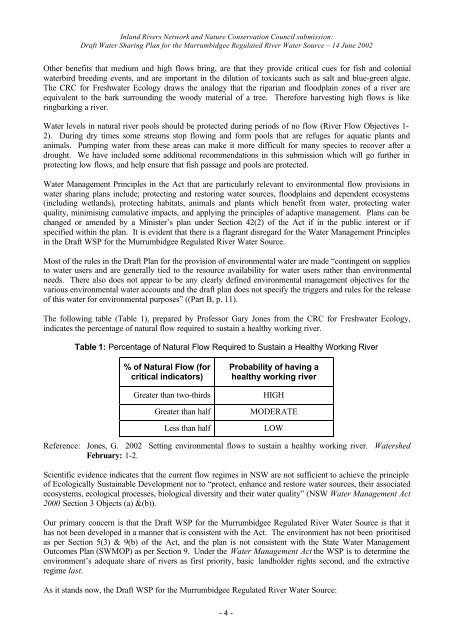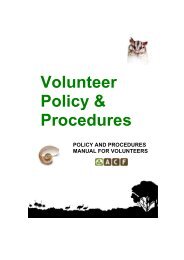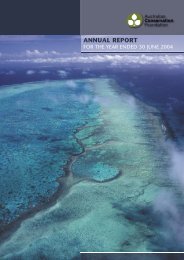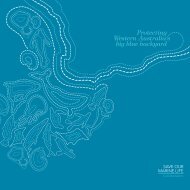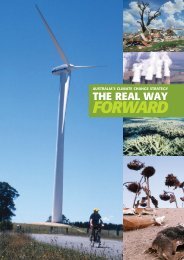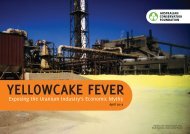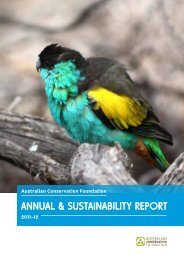Submission on Draft Water Sharing Plan for the Murrumbidgee River
Submission on Draft Water Sharing Plan for the Murrumbidgee River
Submission on Draft Water Sharing Plan for the Murrumbidgee River
You also want an ePaper? Increase the reach of your titles
YUMPU automatically turns print PDFs into web optimized ePapers that Google loves.
Inland <strong>River</strong>s Network and Nature C<strong>on</strong>servati<strong>on</strong> Council submissi<strong>on</strong>:<br />
<strong>Draft</strong> <strong>Water</strong> <strong>Sharing</strong> <strong>Plan</strong> <strong>for</strong> <strong>the</strong> <strong>Murrumbidgee</strong> Regulated <strong>River</strong> <strong>Water</strong> Source – 14 June 2002<br />
O<strong>the</strong>r benefits that medium and high flows bring, are that <strong>the</strong>y provide critical cues <strong>for</strong> fish and col<strong>on</strong>ial<br />
waterbird breeding events, and are important in <strong>the</strong> diluti<strong>on</strong> of toxicants such as salt and blue-green algae.<br />
The CRC <strong>for</strong> Freshwater Ecology draws <strong>the</strong> analogy that <strong>the</strong> riparian and floodplain z<strong>on</strong>es of a river are<br />
equivalent to <strong>the</strong> bark surrounding <strong>the</strong> woody material of a tree. There<strong>for</strong>e harvesting high flows is like<br />
ringbarking a river.<br />
<strong>Water</strong> levels in natural river pools should be protected during periods of no flow (<strong>River</strong> Flow Objectives 1-<br />
2). During dry times some streams stop flowing and <strong>for</strong>m pools that are refuges <strong>for</strong> aquatic plants and<br />
animals. Pumping water from <strong>the</strong>se areas can make it more difficult <strong>for</strong> many species to recover after a<br />
drought. We have included some additi<strong>on</strong>al recommendati<strong>on</strong>s in this submissi<strong>on</strong> which will go fur<strong>the</strong>r in<br />
protecting low flows, and help ensure that fish passage and pools are protected.<br />
<strong>Water</strong> Management Principles in <strong>the</strong> Act that are particularly relevant to envir<strong>on</strong>mental flow provisi<strong>on</strong>s in<br />
water sharing plans include; protecting and restoring water sources, floodplains and dependent ecosystems<br />
(including wetlands), protecting habitats, animals and plants which benefit from water, protecting water<br />
quality, minimising cumulative impacts, and applying <strong>the</strong> principles of adaptive management. <strong>Plan</strong>s can be<br />
changed or amended by a Minister’s plan under Secti<strong>on</strong> 42(2) of <strong>the</strong> Act if in <strong>the</strong> public interest or if<br />
specified within <strong>the</strong> plan. It is evident that <strong>the</strong>re is a flagrant disregard <strong>for</strong> <strong>the</strong> <strong>Water</strong> Management Principles<br />
in <strong>the</strong> <strong>Draft</strong> WSP <strong>for</strong> <strong>the</strong> <strong>Murrumbidgee</strong> Regulated <strong>River</strong> <strong>Water</strong> Source.<br />
Most of <strong>the</strong> rules in <strong>the</strong> <strong>Draft</strong> <strong>Plan</strong> <strong>for</strong> <strong>the</strong> provisi<strong>on</strong> of envir<strong>on</strong>mental water are made “c<strong>on</strong>tingent <strong>on</strong> supplies<br />
to water users and are generally tied to <strong>the</strong> resource availability <strong>for</strong> water users ra<strong>the</strong>r than envir<strong>on</strong>mental<br />
needs. There also does not appear to be any clearly defined envir<strong>on</strong>mental management objectives <strong>for</strong> <strong>the</strong><br />
various envir<strong>on</strong>mental water accounts and <strong>the</strong> draft plan does not specify <strong>the</strong> triggers and rules <strong>for</strong> <strong>the</strong> release<br />
of this water <strong>for</strong> envir<strong>on</strong>mental purposes” ((Part B, p. 11).<br />
The following table (Table 1), prepared by Professor Gary J<strong>on</strong>es from <strong>the</strong> CRC <strong>for</strong> Freshwater Ecology,<br />
indicates <strong>the</strong> percentage of natural flow required to sustain a healthy working river.<br />
Table 1: Percentage of Natural Flow Required to Sustain a Healthy Working <strong>River</strong><br />
% of Natural Flow (<strong>for</strong><br />
critical indicators)<br />
Greater than two-thirds<br />
Greater than half<br />
Less than half<br />
Probability of having a<br />
healthy working river<br />
HIGH<br />
MODERATE<br />
LOW<br />
Reference: J<strong>on</strong>es, G. 2002 Setting envir<strong>on</strong>mental flows to sustain a healthy working river. <strong>Water</strong>shed<br />
February: 1-2.<br />
Scientific evidence indicates that <strong>the</strong> current flow regimes in NSW are not sufficient to achieve <strong>the</strong> principle<br />
of Ecologically Sustainable Development nor to “protect, enhance and restore water sources, <strong>the</strong>ir associated<br />
ecosystems, ecological processes, biological diversity and <strong>the</strong>ir water quality” (NSW <strong>Water</strong> Management Act<br />
2000 Secti<strong>on</strong> 3 Objects (a) &(b)).<br />
Our primary c<strong>on</strong>cern is that <strong>the</strong> <strong>Draft</strong> WSP <strong>for</strong> <strong>the</strong> <strong>Murrumbidgee</strong> Regulated <strong>River</strong> <strong>Water</strong> Source is that it<br />
has not been developed in a manner that is c<strong>on</strong>sistent with <strong>the</strong> Act. The envir<strong>on</strong>ment has not been prioritised<br />
as per Secti<strong>on</strong> 5(3) & 9(b) of <strong>the</strong> Act, and <strong>the</strong> plan is not c<strong>on</strong>sistent with <strong>the</strong> State <strong>Water</strong> Management<br />
Outcomes <strong>Plan</strong> (SWMOP) as per Secti<strong>on</strong> 9. Under <strong>the</strong> <strong>Water</strong> Management Act <strong>the</strong> WSP is to determine <strong>the</strong><br />
envir<strong>on</strong>ment’s adequate share of rivers as first priority, basic landholder rights sec<strong>on</strong>d, and <strong>the</strong> extractive<br />
regime last.<br />
As it stands now, <strong>the</strong> <strong>Draft</strong> WSP <strong>for</strong> <strong>the</strong> <strong>Murrumbidgee</strong> Regulated <strong>River</strong> <strong>Water</strong> Source:<br />
- 4 -


